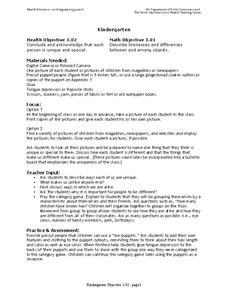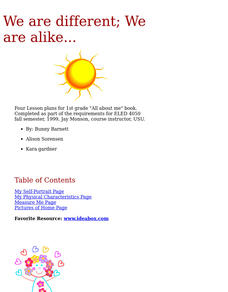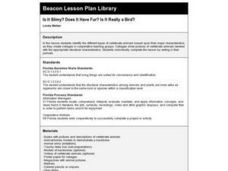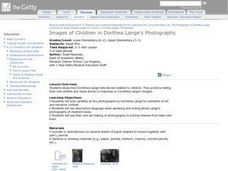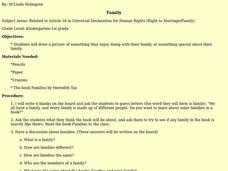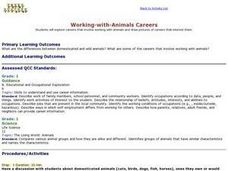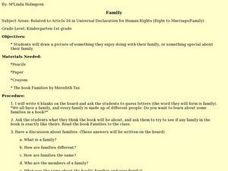Curated OER
We Are All Different in Many Ways!
Students draw a picture with only one color crayon. As a class, they discuss how the world would be different if there were only one color crayon to use. After being read a book, they discuss how each person is important even though...
Curated OER
We Are All Different in Many Ways!
Pupils discuss differences such as skin color, eye color, hair color, emotions, families, etc., to reinforce that it is okay to be different.
Curated OER
Author Study: Laura Ingalls Wilder
Students read novel, Little House in the Big Woods, explore web sites and other resources devoted to author, Laura Ingalls Wilder, complete Venn Diagram showing ways they and author are alike and different, and create diorama, read...
Curated OER
Language Arts: Word Recognition and Mental Images
Students read short stories containing Dolch sight words and describe the scenes and answer comprehension questions. After relating the stories to their own experiences or observations, they draw pictures illustrating a scene from the...
Curated OER
Animals and Humans
Students identify the functions of various body parts. They participate in the "Head, Shoulders, Knees, and Toes" song, draw a picture of themselves and other mammals, and create a traced outline of their body that they add features to....
Curated OER
Picture an Astronomer
Students create a drawing of what an astronomer looks like. They explore their own assumptions of those who work in the sciences.
Curated OER
I Am Special
Students conclude and acknowledge that each person is unique and special. In this I Am Special lesson plan, students compare their digital photograph to pictures of people in magazines to determine likenesses/differences. They describe...
Curated OER
Look Alikes
Third graders compare and contrast the physical features of parents and offspring. In this life science lesson, 3rd graders classify a set of animal pictures according to their similarities. They share and explain their work in class.
Curated OER
We Are Different; We Are Alike........
First graders explain that everybody is unique in their own way by participating in this lively, art and language based series of lesson plans. They would greatly benefit from engaging in these plans in the beginning of the year as an...
Curated OER
Classifying Vertebrates
Second graders study animal characteristics and classification. For this animal characteristics and classifications lesson, 2nd graders determine how to classify vertebrates which include mammals, reptiles, amphibians, birds, and fish....
Curated OER
Identifying Fossils
Students create model fossils. For this fossils lesson, students view pictures of fossils and compare and contrast these fossils. Students read about fossils and create a database chart with the facts they learn. ...
Curated OER
Is It Slimy? Does It Have Fur? Is It Really a Bird?
Sixth graders identify the different types of vertebrate animals based upon their major characteristics, as they create collages in groups. Collages show pictures of vertebrate animals labeled with the appropriate structural...
Curated OER
Activity Plan 3-4: Dreamy Rhymes
Learners write a story about an animal using rhyme. In this literacy lesson plan, the teacher shares different versions of "Mary Had a Little Lamb" with the class and that becomes the basis for the creation of a picture and story for...
Curated OER
Images of Children in Dorthea Lange's Photographs
Students research the photographs of Dorthea Lange. In this visual art lesson plan, students look at photographs of children taken by Lange and answer several questions. They write or tell stories to explain what they think is occurring...
Curated OER
Anty-Bodies
Students compare and contrast likenesses and differences to others by creating a life-size picture of themselves. In this character building lesson, students dictate a sentence about comments on sharing and display them with their...
Curated OER
Animals and Animal Babies
Students examine how some animal young are similar to the adult. They look at pictures of various animals and their young and identify if they look similar or not similar to the adult animal, and draw a picture of a baby and parent...
Curated OER
IDENTIFYING AND SORTING BEARS
Students study the difference between living and nonliving bears by classifying pictures of bears and placing them on the appropriate posterboard. Given pictures of bears, students recognize types of bears by placing the pictures correctly.
Curated OER
Family
Students listen to a teacher read aloud of a book about families before discussing what a family is to them. They discuss how families can be the same or different, who they are made of, and what their traditions might be. They draw a...
Curated OER
I've Seen That Shape Before
Students identify geometric solids. In this shape instructional activity, students explore the characteristics of geometric solids. They locate pictures of shapes on the internet, and identify the shapes. Students draw...
Curated OER
Big Cat Classification
First graders discover the different names and classifications of big cats by using word processing applications. In this animal life lesson, 1st graders investigate one big cat and create a database of facts about it using an word...
Curated OER
Working-with-Animals Careers
First graders list and discuss careers that involve working with animals and draw pictures of careers that interest them. They compare and contrast domestic and wild animals.
Curated OER
Shapes are Everywhere
Second graders gain an understanding of geometric shapes and spatial reasoning. They learn the attributes of solid shapes in everyday activities. Students compare geometric shapes to everday objects, finding things that serve a purpose...
Curated OER
Family
Students draw a picture of something they enjoy doing with their family, or something special about their family. Students share their pictures with the class, and then they will be displayed in the classroom.
Curated OER
Tools of the Trade
Students create and then play a game similar to Memory, which encourages them to recall what they have learned about different occupations and the related tools.








